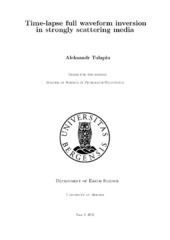| dc.description.abstract | In petroleum seismology, full waveform inversion (FWI) is known as a powerful method taking into account all available in seismic data information with which one can determine a high-resolution subsurface image. In time-lapse seismic, the use of FWI is even more valuable since it makes it possible to monitor changes in model parameters. These changes are often associated with changes in physical conditions in a hydrocarbon reservoir. In high-contrast media, such as salt-affected regions for example, where petroleum traps are often located beneath large salt bodies, the application of FWI methods encounters two main problems: the absence of an accurate initial model to start an inversion workflow and, the absence of ultra-low frequencies in real seismic data. These issues often cause FWI algorithms to be ineffective. This thesis presents the Distorted Born Iterative T-matrix (DBIT) nonlinear inversion method integrated with smoothing and self-adaptive techniques to deal with these problems in the context of strongly scattering media models. The proposed approach was applied to synthetic data, which were generated using the T-matrix integral equation method. The T-matrix integral equation method is a modelling technique used to model synthetic data. Through a systematic comparison of this method with finite-difference modelling, it was found that this technique can be considered to be exact. This makes it attractive to DBIT, i.e. T-matrix modelling based inversion. A lack of ultra-low frequencies (1-4 Hz), when experimenting with the modified high-contrast EAGE/SEG salt models, caused the DBIT inversion algorithm to diverge. However, the application of smoothing (multi-scale regularization) and self-adaptive (a method for choosing the regularization parameter) techniques, solved this problem and the DBIT-based FWI method successfully recovered the analyzed models. The time-lapse application showed that for noisy data, only the high-contrast time-lapse velocity anomaly (velocity difference of 600 m/s) could be restored. For the low-contrast velocity difference (velocity difference of 200 m/s), the time-lapse anomaly on the recovered model failed to be resolved. A comparison of two different time-lapse strategies (parallel difference and sequential) demonstrated that the sequential approach worked faster and more accurate. The DBIT inversion method, in combination with the smoothing and self-adaptive techniques, can be considered as an effective tool for strongly scattering media model recoveries. | en_US |
